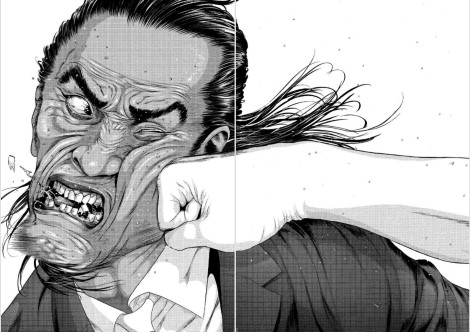Comics are a visual medium, but so often criticism of the medium hinges on narrative, ignoring or minimizing the visual storytelling and unique structures that make comics so different from cinema and photography. We’ve decided to change that up with a feature that we’re calling Anatomy of a Page, in which we explore pages and panels that showcase the language of comics and how the best visual storytellers maximize the freedom of comics in order to tell stories that can’t be told anywhere else. This week’s Anatomy of a Page goes down an altogether different route, though, as it explores the way Hiroya Oku subverts the standard comics notions of what a two-page spread is meant to do. Austin Lanari singles out Inuyashiki as an especially blatant flip of the superhero spread, freeze framing not on bombastic, action-filled scenes but quiet or tense moments where Oku’s 3D rendered background become the focus.
Hiroya Oku is most well-known for his extensive use of 3D modeling for nearly everything in his stories that isn’t a human. He learned to 3D model in order to lend a “unity” to his futuristic backdrops for his failed series 01 Zero One, and went on to employ the technique extensively in his far more successful series, Gantz. The scope of Gantz is often too ambitious, with Oku’s brash styling bouncing between contemplations of love, death, and personal identity, nearly all of which are half-assed. The visuals of Gantz are similar to the ideas in that they are over-saturated, yet still somehow manage to lack any real substance.
His newest series, Inuyashiki, continues to deploy the same 3D modeling, but to much greater success. The main reason? Oku’s bombastic rendering of particular objects and scenes lends an almost ironic gravity to small-scale moments of super-heroism. Inuyashiki inherits a lot of its epic qualities by intentionally running afoul of superhero comic norms, making the mundane seem super in the process without flashy capes, colors, or creeds.
Above is the first of not one, not two, but five two-page spreads (!!!) in Chapter 25 of Inuyashiki. So much of what is impressive about Oku’s vision for this series is apparent in the previous two pages alone. Inuyashiki is a series about the titular character who is 58, looks much older than 58, is a constant disappointment to his nagging family, gets killed by some kind of UFO, and then repaired by those aliens via having his innards replaced–including his brain, though it is programmed with his personality–by an artificial intelligence designed for war.
From this spread, we get the unassuming nature of Inuyashiki; of course, he’s unassuming at all times, but seeing him juxtaposed next to the massive gangster who has already tried to murder him punctuates the point nicely. Frequently, confrontations in this series, or moments where Inuyashiki’s powers are showcased occur against normal, serene, and unmistakably Japanese backdrops like this one. This is a massive departure from Oku’s intricate, futuristic styling, which is only showcased in this series once in awhile when Inuyashiki has to face several evil-doers at once.
And yet the most grandiose artistic decision that Oku has made is this spread itself, let alone the choice to include four other spreads just like it within a single issue. Two-page spreads in a superhero book are supposed to showcase entire superhero teams in action, one-on-one battles between immensely powerful figures, and all, typically, within detailed and exotic locales. This spread, along with this issue, along with probably this entire series, is Oku giving one whopping middle-finger to superhero comics while, in the process, assembling a charming little superhero tale of his own.
Just look at this. This is the fourth of the two-page spreads in this issue and it’s absolutely merciless. No other superhero book that you are likely to read–even ones being unironically heavy-handed–are going to pour it on this thick with this many spreads [interestingly enough, though, In-Hyuk Lee’s 100th Anniversary of Spider-Man one shot has a panel that eerily syncs up with this one and came out at almost the exact same time- ed.]; but, even one spread in the average superhero comic is more obnoxious than any of the spreads in Chapter 25 of Inuyashiki. All that happens here in two entire pages, after all, is a fist hitting someone’s face, hard. Such storytelling is completely contrary to the contemporary emphasis on (or obsession with) “efficiency” in visual storytelling. Flaunting the violation of these kinds of unwritten maxims is one of the things that puts Inuyashiki a notch above more routine superhero tales.
These spreads are ambitiously unambitious, much like the series itself. Upon realizing that his innards have been replaced, including his brain, Inuyashiki has a moment where he grapples with the questions of personal identity that necessarily follow. But rather than tie us up in some Lockean meditation regarding causation, memory, and identity, Oku has Inuyashiki do little more than shrug and get on with facing his responsibility as a hero. Oku has not only overcome his bad habits from Gantz–habits thematic, philosophical, and artistic–but also repurposed some of them to create an aggressively intimate story as unassuming, but quietly powerful, as Inuyashiki himself.
Austin Lanari is a recovering philosopher who can never catch up with any of the goddamn anime he wants to watch. He disgorges comicy thoughts and criticism for Comic Bastards and on his own blog. You can read those thoughts and less on Twitter @AustinLanari.



For me it’s still the same crap as GantZ, both artistically and in the narrative, it’s prescient as hell. And even worse, he puts in the narrative some hints that I remember A Dama do Lago do Shayamala, is literally to say that “when I die you will think I’m the best”, but if you don’t take Iniyashiki as seriously as the manga does and iguinor this horrible 3D with these textures and this horrible perspective you will laugh a lot reading.